One of the most important duties of a pet owner is to ensure their pet is eating properly. To make sure your pet is eating properly, you have to research their diet, feeding habits, etc, no matter what their pet animal is.
The research should be even more thorough when it comes to exotic pets such as axolotls as there are plenty of reasons these animals will stop eating. This will lead to an inexperienced owner asking, “why is my axolotl not eating?”
The reasons for an axolotl not eating can be manifold. They may be stressed out due to new tank conditions, have issues with food and water, have unsuitable tankmates, have blocked digestive systems, etc. Their not eating might also be due to egg retention among others.
Let’s take a detailed look at why an axolotl might stop eating.
Your Axolotl Has Stopped Eating, What Could Be The Reasons?
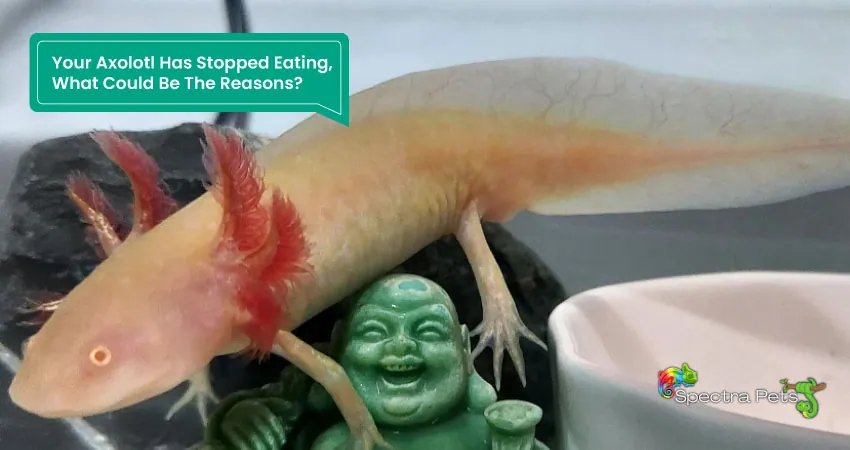
Axolotls are pretty sensitive when it comes to their environment. The slightest disturbance and anomaly in their tank conditions can lead to them not eating. Let’s take a look at all the reasons why your axolotls might stop eating:
1. Stressed out due to new tank conditions
When any animal is moved to a new environment, it takes some time before they are fully acquainted with its surroundings. This is even truer for axolotls since they live in a particular environment in Mexico. That’s why these animals are moved into a new tank, they are stressed out by the new environment and stop eating for a day or two. Once they are fully acclimated to the tank’s environment, they’ll start eating.
2. The water temperature is too high
Axolotls live in moderately cool waters, so they require their tank water to be within that range of temperature. Once the tank water approaches 23 degrees Celsius temperature, it becomes increasingly stressful for the axolotls to stay in it, and they stop eating. If the temperature goes beyond 24 degrees, the animal might even die.
3. Issues with their food
Another reason axolotls might stop eating is that the food they are being provided with is not up to the mark, or it doesn’t suit them. If the food is too big for them to bite, they won’t eat it. The same thing will happen if the food you are giving them is too tough for them to bite or if it is expired.
4. Unsuitable tankmates
Axolotls, especially young ones, are extremely violent towards each other and resort to cannibalism. So, if you put more than one young axolotl in one tank, the more stressed one will stop eating and will eventually die, either by starvation or by being killed by another axolotl.
Additionally, if you keep multiple adult axolotls in one tank, sometimes one gets too aggressive and keeps attacking the other one. As a result, the more timid axolotl can not eat properly and starves. If you see such behavior, it’s best to separate the two animals for their own sake.
5. Blocked digestive system
One of the major reasons why you shouldn’t put gravel in your axolotl tank is that the animals can sometimes accidentally ingest this gravel. These then can block their digestive system, which can keep them from eating. This is called impaction and should be treated as soon as possible to save the axolotl’s life.
6. Egg retention
Although rare, egg or water retention does happen among axolotls, which can prevent them from eating. This is particularly common in female axolotls, as their eggs can sometimes stay in their bodies and can be fatal for them. The best way to solve this issue is to keep the female axolotl with a male so that they lay the eggs or to have some plants or vegetation for them to have a place to lay eggs.
7. High ammonia levels
Axolotls simply can not tolerate higher levels of ammonia in their tank water. This can happen due to warm water temperatures or if the tank is not cycled properly. If that happens, your axolotl will stop eating and starve to death unless you install a filter in the tank or change the tub water every day.
8. If the water temperature is too low
I mentioned how warm waters don’t suit axolotls and end up stopping their food intake. That same is the case when the tank water is too cold. If the water temperature drops below 15 degrees Celsius, it will make the axolotl think that winter has come, and they will start reducing their food intake as they prepare for hibernation. So it’s best if you keep the water temperature between 15 and 23 degrees Celsius.
9. Presence of parasites
If you see that your axolotls are not taking food and vomiting the food they have already eaten, and you are sure that none of the aforementioned issues is the cause for this, then it might be because of the presence of parasites. In this case, take your axolotls to a vet and treat them accordingly.
10. Constipation
Young axolotls, which are not yet accustomed to eating food pellets, can sometimes suffer from constipation. This happens if they can’t properly digest their food, especially the ones containing fish bones, crustacean shells, etc. If that happens, these young animals will stop eating.
11. The tank water hasn’t completed its nitrogen cycle
Another reason axolotls not eating is that the water in the tank has too much nitrogen in it. If you rush your axolotl too early into the tank, then it will face water that has yet to complete its nitrogen cycle and will stop eating.
12. The tank has powerful filters
Axolotls are used to still and calm waters. So if you have powerful filters that create too much turbulence and noise in the water, it will greatly impact the well-being of the axolotl. This will cause the animal to become stressed and stop eating altogether.
13. You have overfed your axolotl
Most animals are not like humans, as they won’t eat if they are full. If you overfeed your axolotl, it will simply refuse to eat. Adult axolotls don’t need to be fed every day; feeding them twice or thrice a week is just fine. If you put too much food in the tank or feed them every day, then eventually they will stop eating until they’re hungry again.
14. Your axolotl is sick
If your axolotl is sick for any reason, then it will not eat. Also, if the animal is wounded, it will result in your animal refusing to eat. In such circumstances, you need to take immediate steps to help your lovely pet to come out of this stressful situation. You should also contact a vet before it gets too late.
How long can axolotls go without eating?
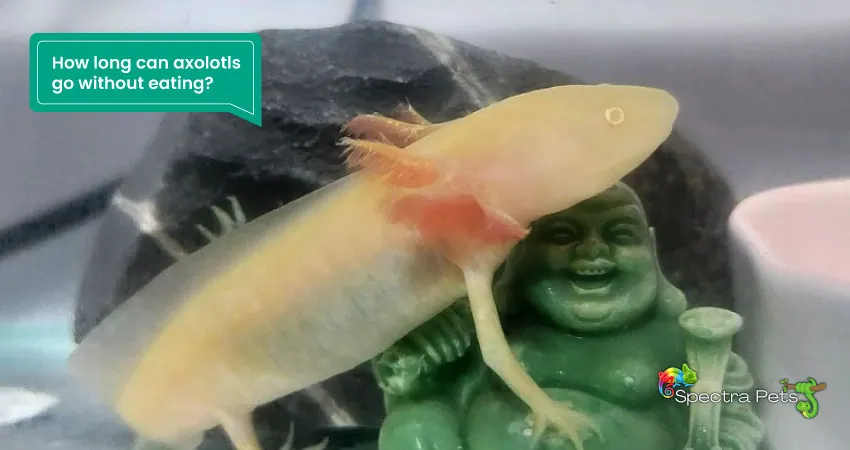
As axolotls are not native to the UK, they have to be imported from other EU countries. So naturally one might wonder “How long can axolotls not eat?” Since they have to be flown thousands of miles to the UK, it would catastrophic if they couldn’t survive a long time without food.
When it comes to food, axolotls can last quite a long time without eating. This is why they can be easily transported from one place to another. Wild axolotls can survive for about 2 weeks without eating. So will Axolotls starve? Not if you feed them within these two weeks.
Should I force-feed my axolotl?
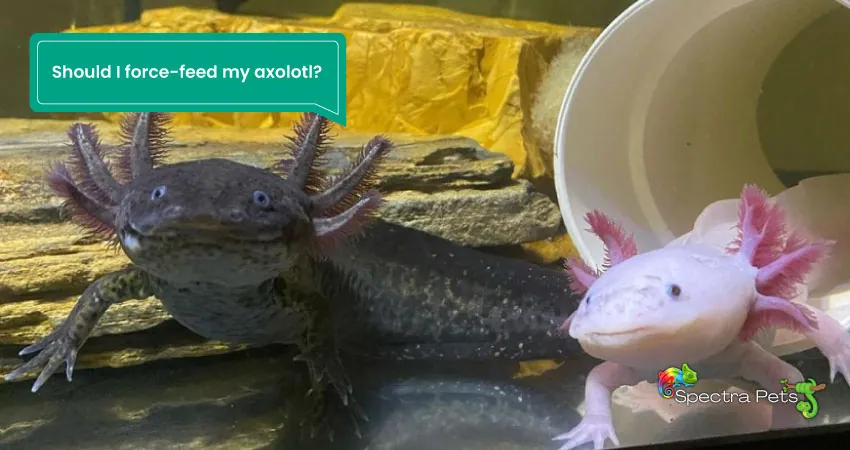
Whether you should force-feed your axolotl or not will depend on the situation your pet is in. If it is in perfect health, then you should never force-feed your axolotl, as it will simply stress the animal out and be counter-productive. On the other hand, if your axolotl is not eating for a long time and is at risk of dying due to starvation, then you should force-feed it.
Force-feeding an axolotl is not an easy job, though. You will need two people to do this, one will hold the animal and open its jaws and the other person will feed the animal. But remember, once you force-feed an axolotl, it will be scared of you.
Read Next: What Do Axolotls Eat
How do you tell if an axolotl is stressed?
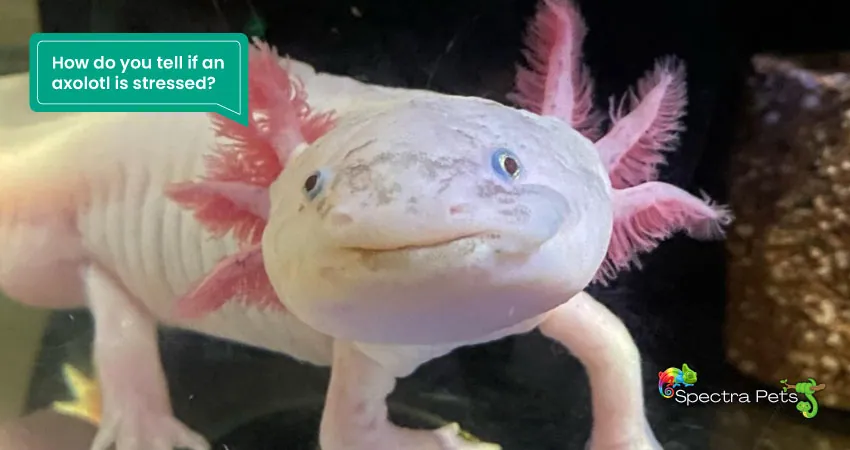
As I mentioned earlier, an axolotl will not eat if it’s stressed. But how can you tell if it’s stressed or not? There are a couple of ways to tell if your axolotl is stressed. First, it will not eat. Since I have discussed it at length above, let’s move on to the next one.
The second indicator that your axolotl is stressed out is when you see its gills curled forward. Axolotls have very prominent gills that are usually laid back when they are feeling alright. But when they are stressed out, these gills will face forward. If that happens, find out if they are being stressed due to tank conditions or having an aggressive tankmate.
Are axolotls picky eaters?
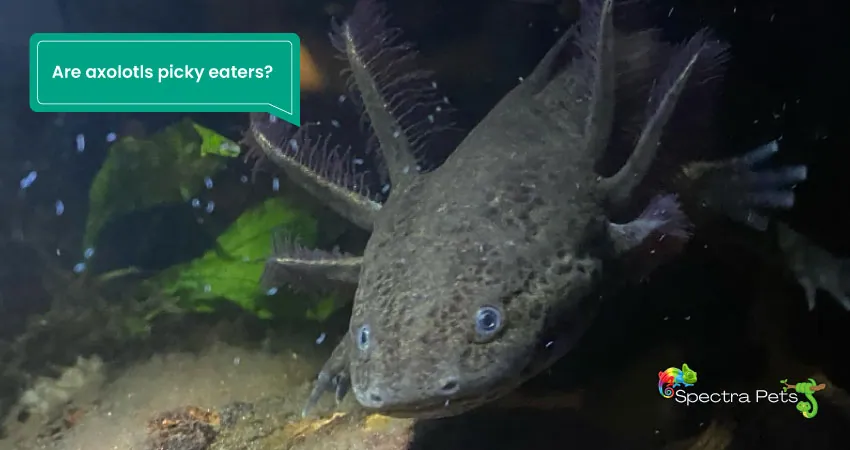
One of the biggest reasons axolotls are harder to keep as pets is they are very picky eaters. They don’t take well to new food. They also tend not to eat food that is not wiggling. Sometimes they will take a few days before adapting to a new food. But if they are not eating something, and you are still trying to feed them that, they will never eat that and starve themselves to death.
What to do if your axolotl is not eating?
If your axolotl is not eating, try to find out what is the cause of their starvation. You can do the following to make it resume eating:
- Ensure the tank water is within the right temperature range
- Keep the ammonia and nitrogen levels low.
- Cut the food into bite-sized pieces
- Install a quiet filter into the tank
- Check the axolotl for impaction and/or constipation
- Take it to a vet to check for parasites and sickness.
- Ensure a pregnant axolotl can lay eggs
- Separate it from aggressive tankmates.
- Give it time to get accustomed to its new surroundings.
Why is my axolotl floating and not eating?
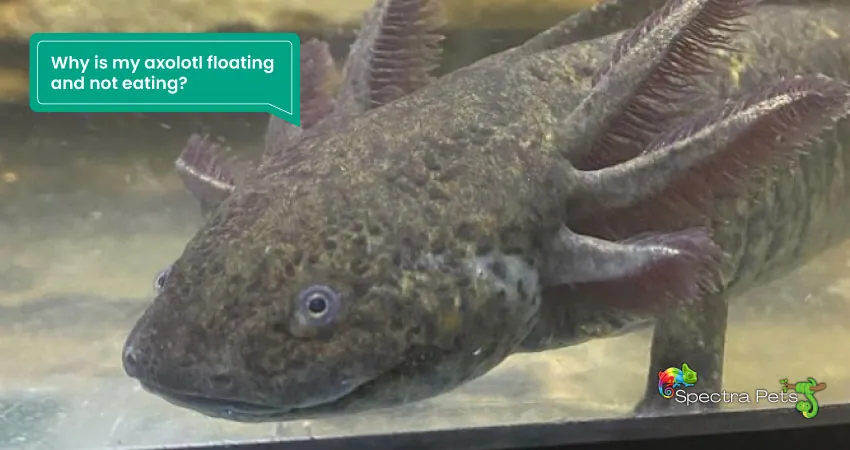
Axolotls love to walk around the bottom of the tank. They rarely come up to the surface, and even if they do, they don’t float on the water’s surface. So if you see your axolotl has stopped eating and also floating on the tank water’s surface, it might be due to the animal having gas. Another reason it might do this is because of constipation.
How do you stimulate an axolotl?
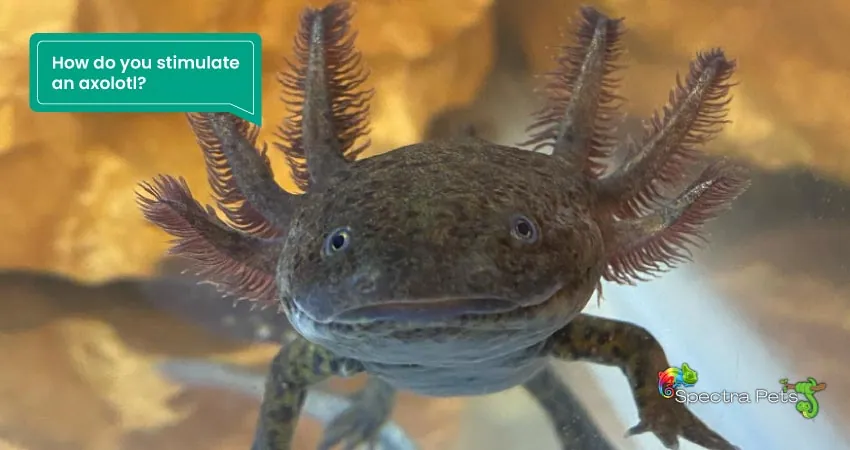
Stimulating an axolotl is very effective in keeping it healthy and functioning. If you think just putting them in a tank and feeding them is enough for the well-being of the animal, then you are gravely mistaken. Like every other animal, axolotls have to be kept in an environment that mimics their natural habitat as much as possible.
Since axolotls live among aquatic vegetation, you should put some plants into the tank to best imitate the natural habitat of axolotls. Additionally, you can put some decorations inside the tank to stimulate it as well.
Final Words
Owning a pet can be exhausting, especially if it’s something as sensitive as an axolotl. So if you see your axolotl has suddenly stopped eating, and you have no prior experience having axolotls as pets, it’s only natural to ask the professionals, “Why is my axolotl not eating?” While keeping an axolotl, you should pay attention to every minute detail to ensure that your pet axolotl is in perfect health and is eating regularly.
